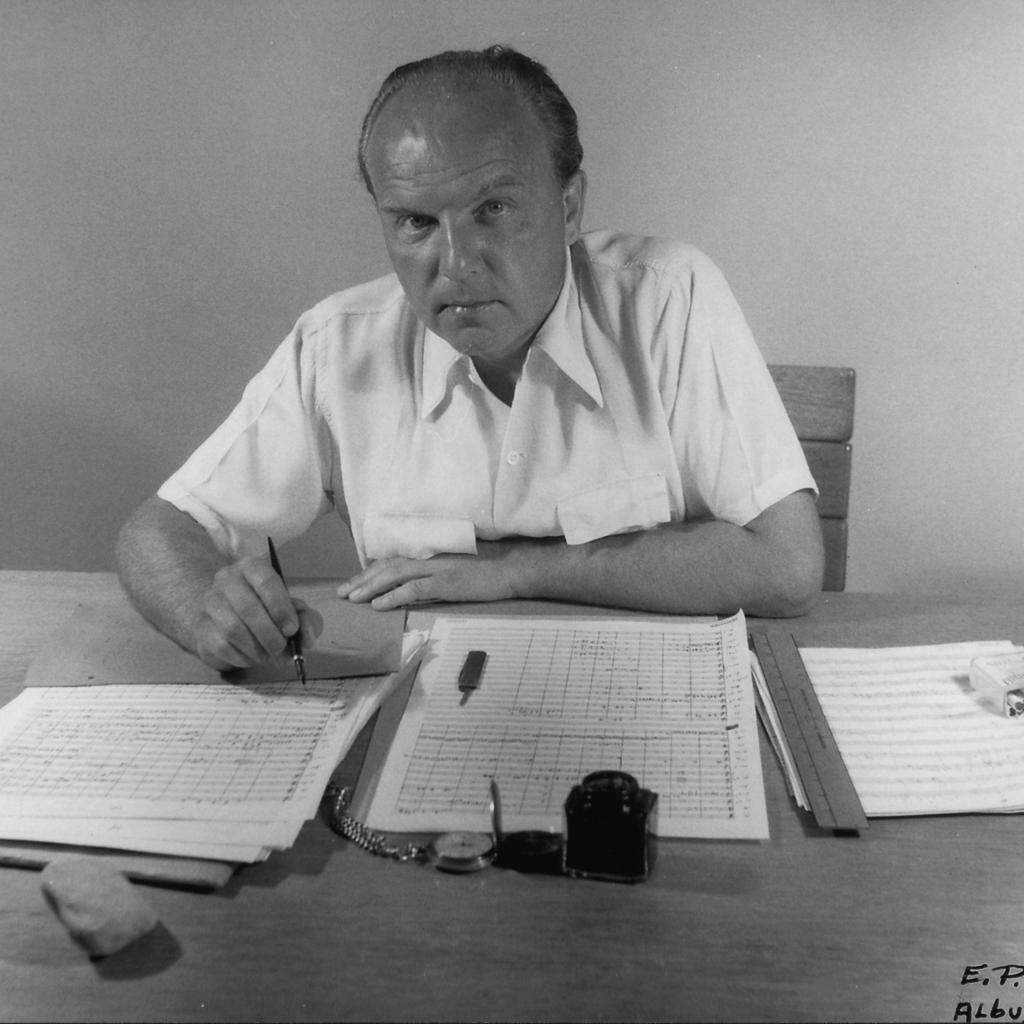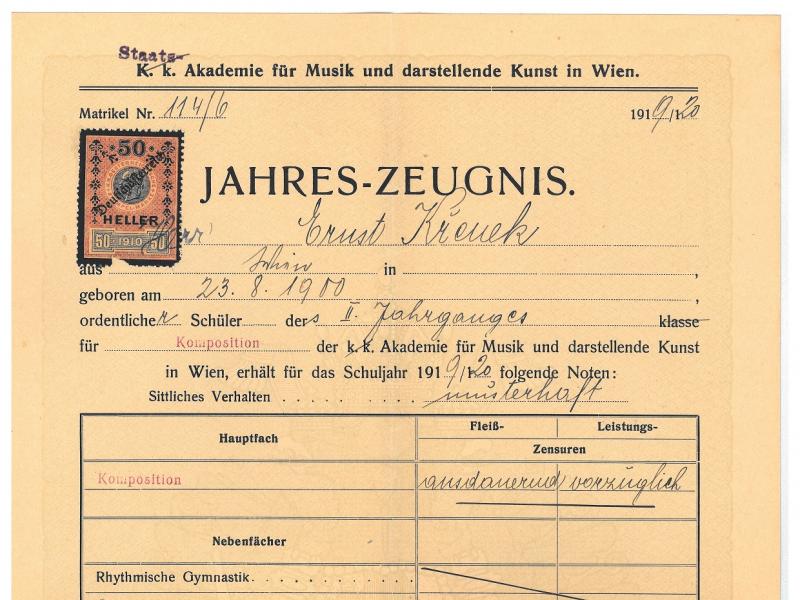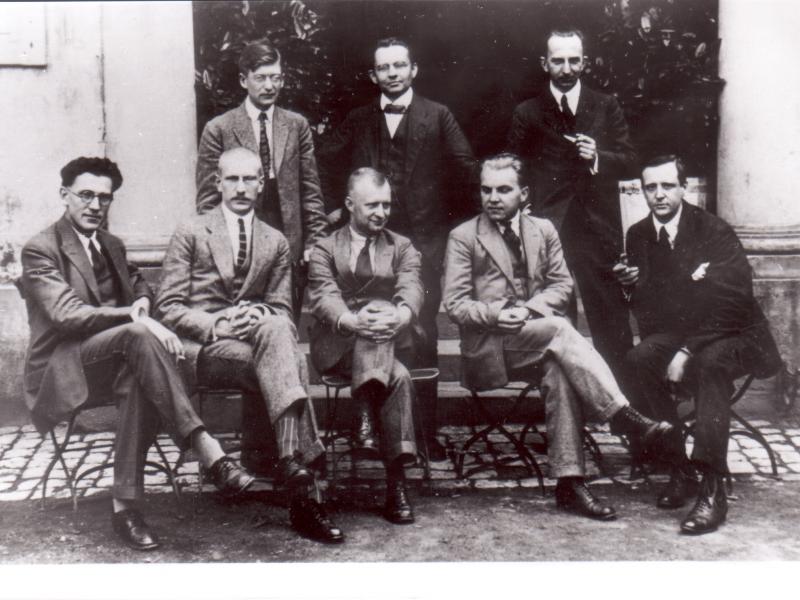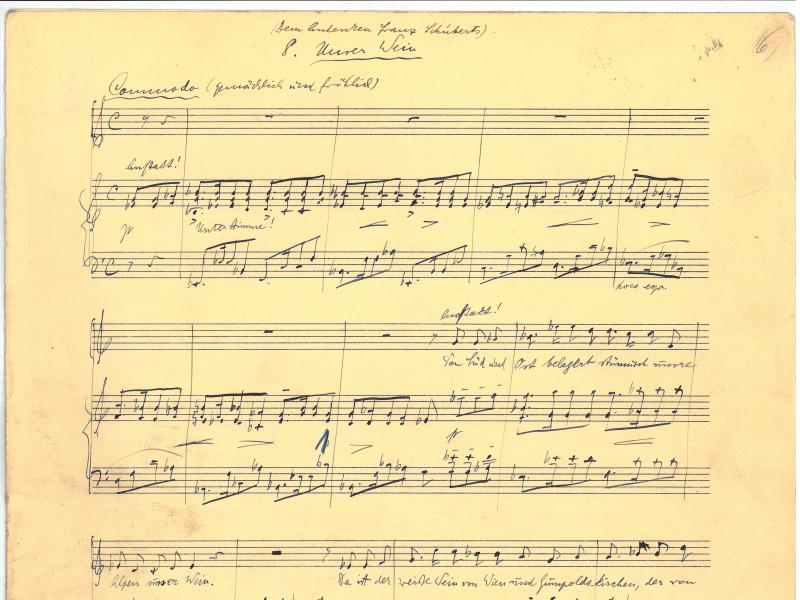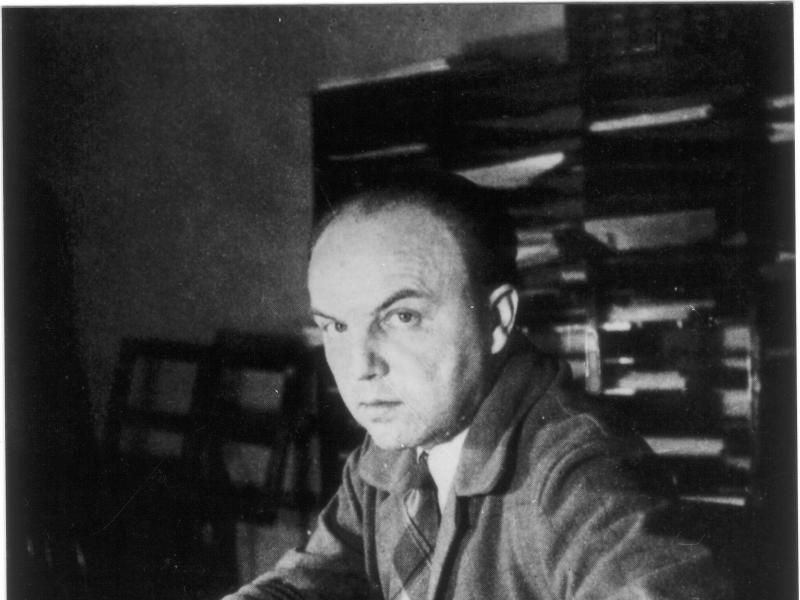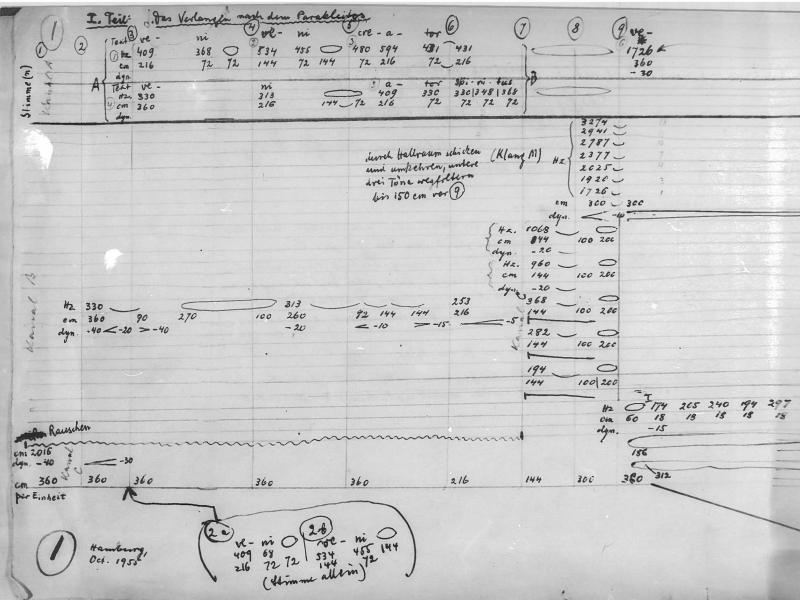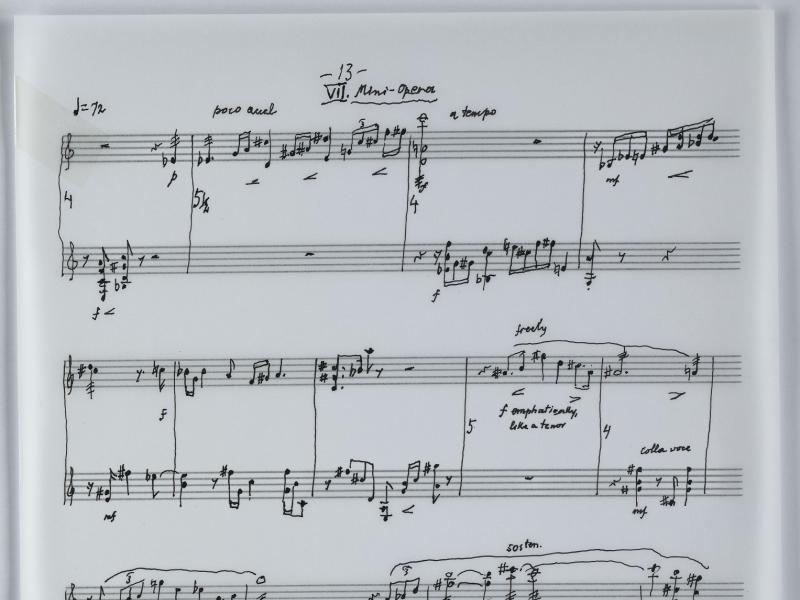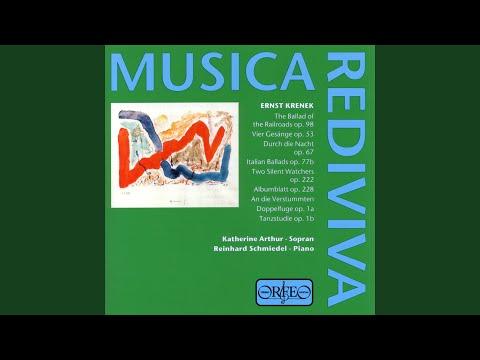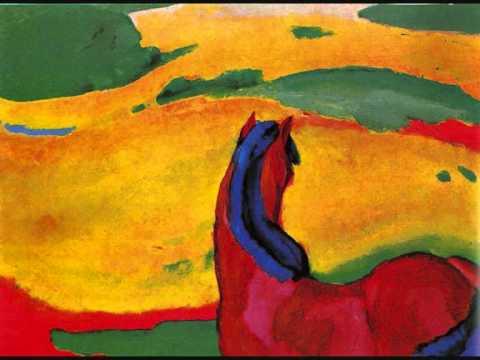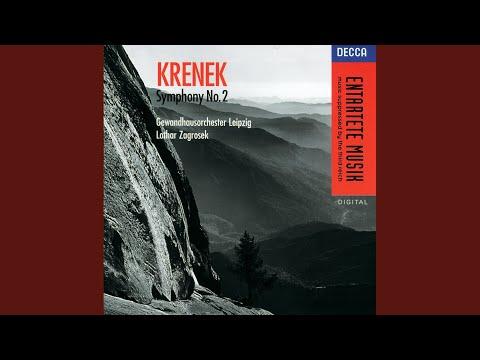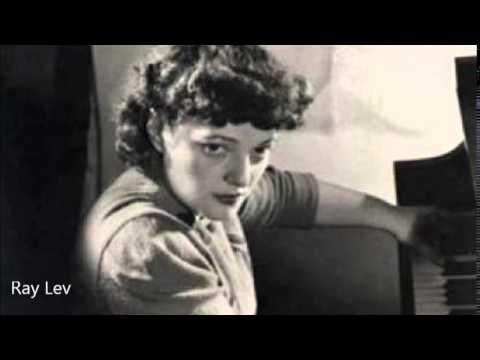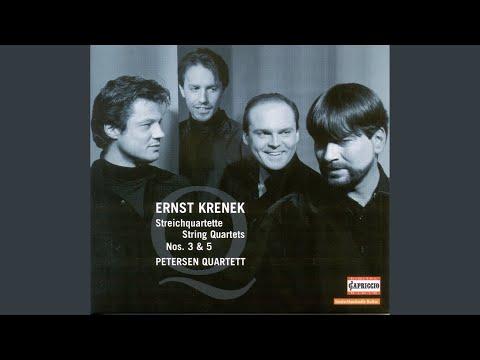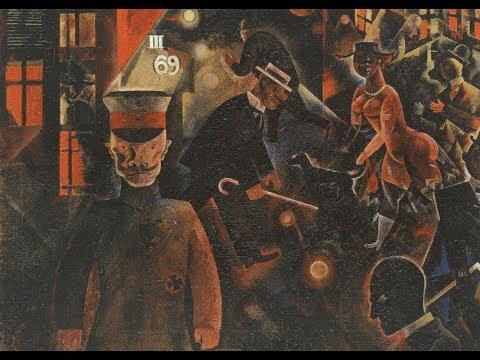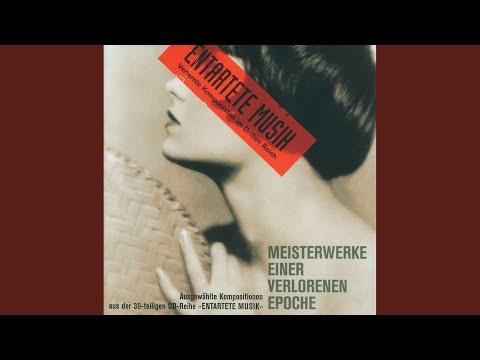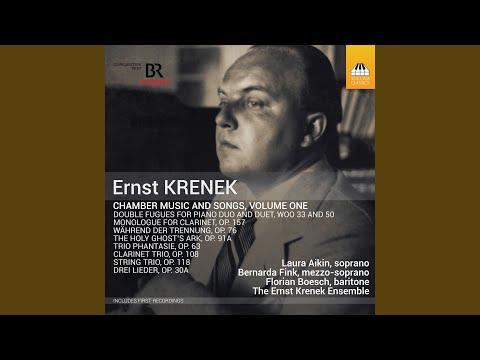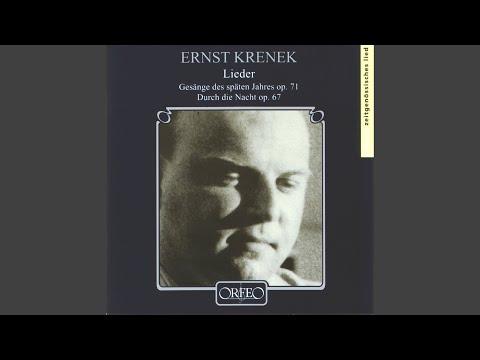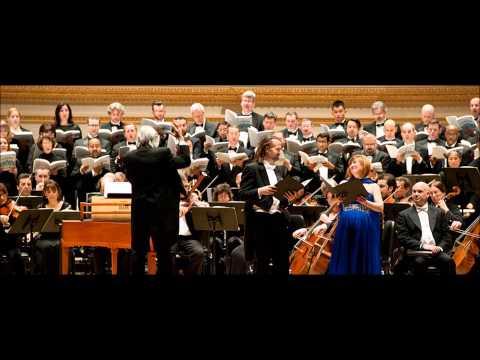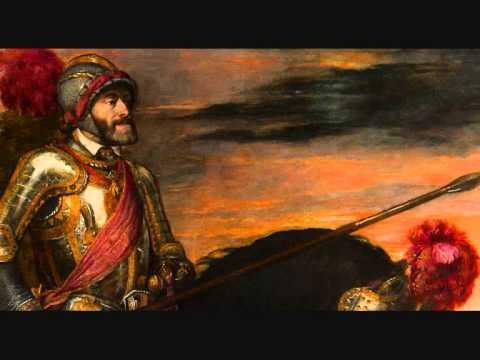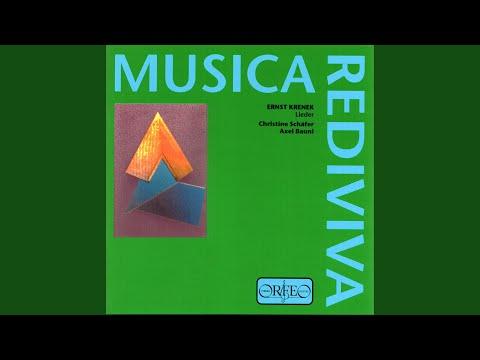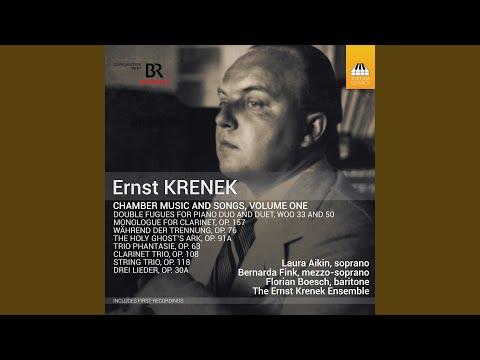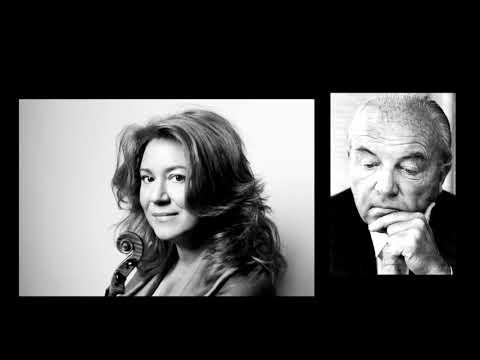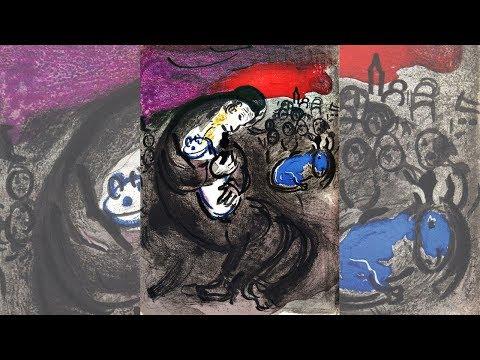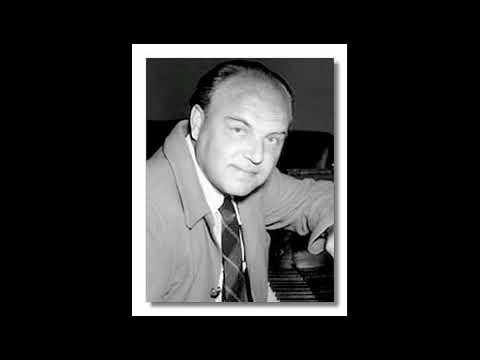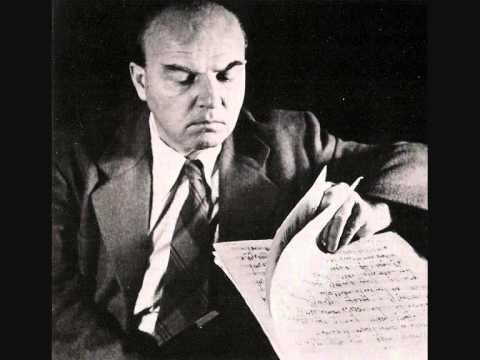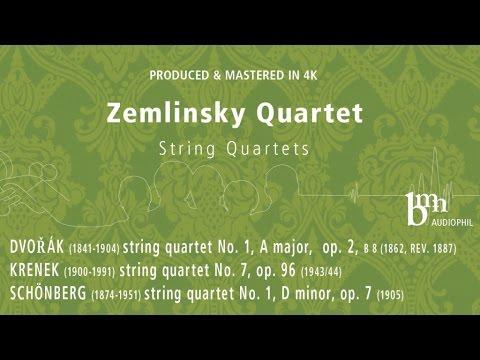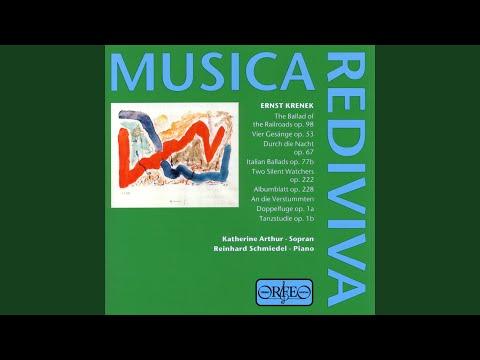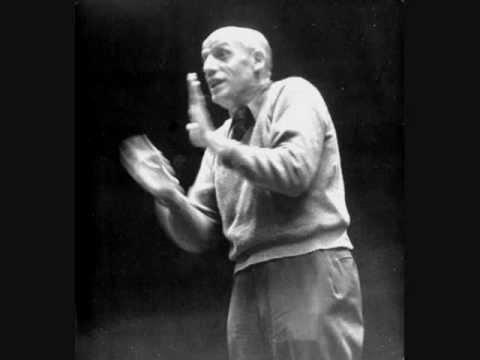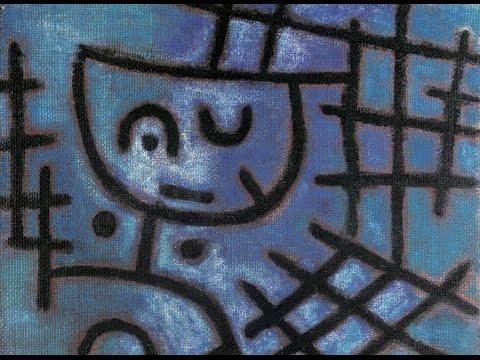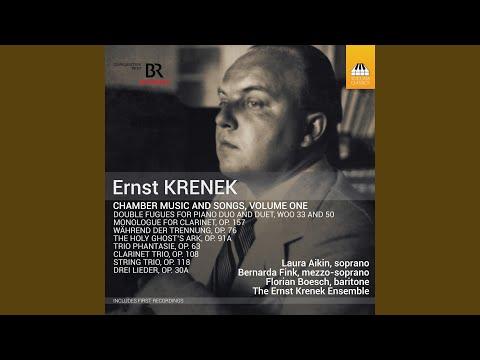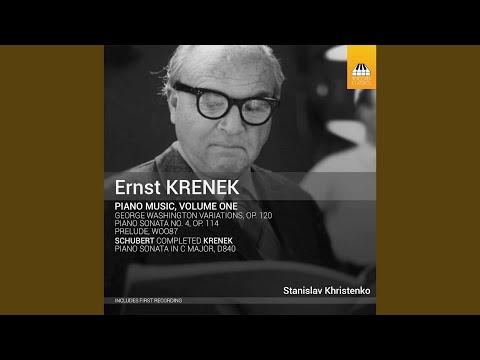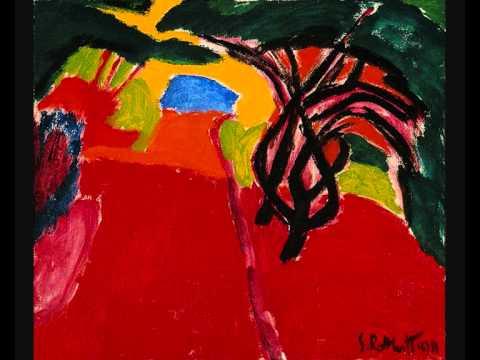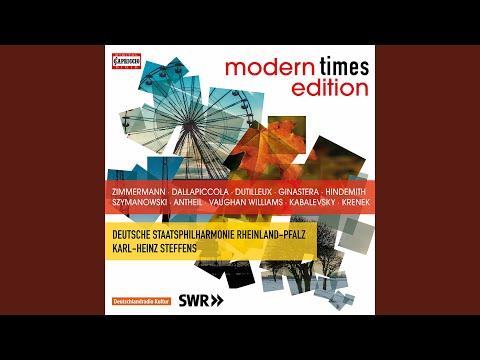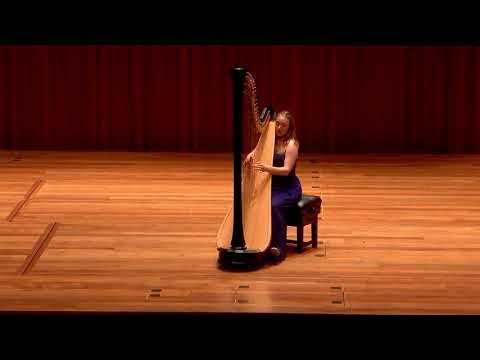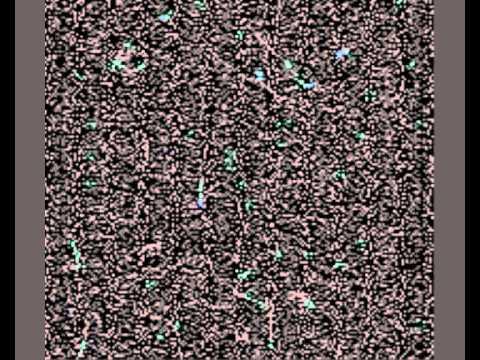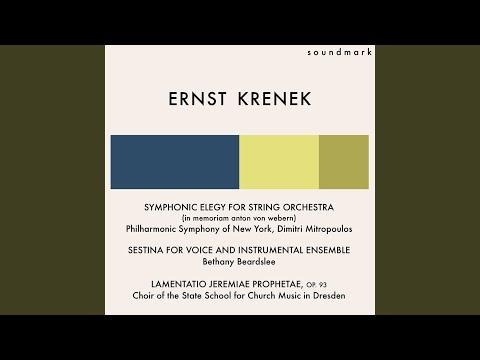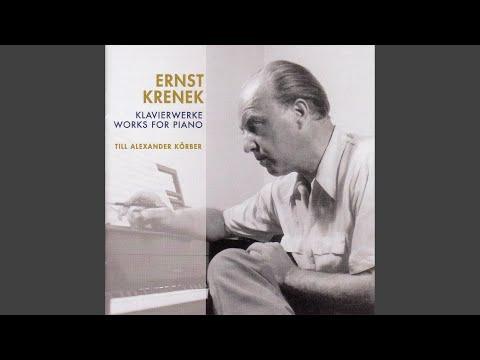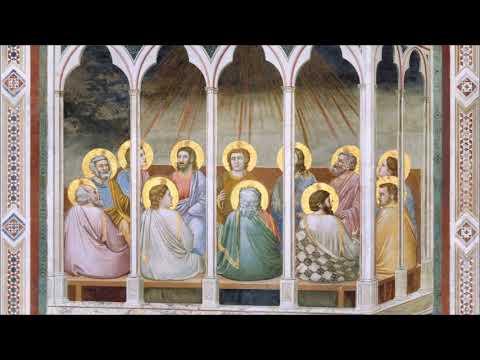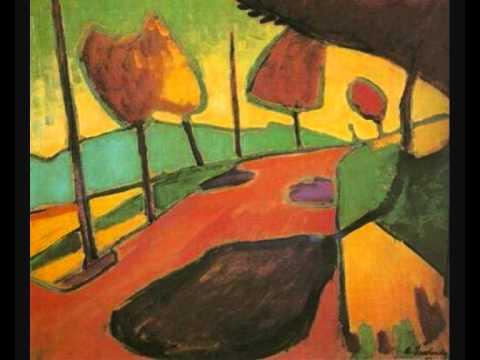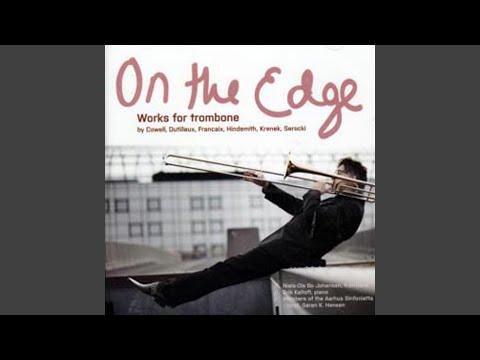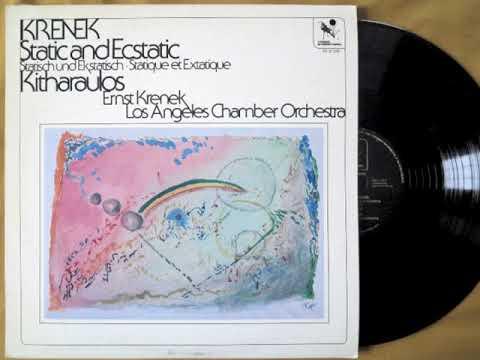Multifaceted and versatile
Ernst Krenek’s long life, his inexhaustible creative energy, and a continual willingness to further develop his compositional means of expression led to an extensive musical œuvre.
In their heterogeneity of form and tonal qualities, his more than 250 works exhibit a unique range among the composers of the twentieth century. Among the attempts to grasp this spectrum, Glenn Gould’s pointed characterization of Krenek as a ‘one-man-history-of-20th-century-music’ is very frequently quoted.
In the following text, we explore Krenek’s various creative periods: from early childhood to mature old age after eight creative decades!
With many examples the musical chronology additionally offers the opportunity to get an aural impression of Krenek’s development and the expansion of his musical means of expression.
If a composer changes the style of his writing, he usually causes bewilderment among his contemporaries. He seems to compare unfavorably with the great masters of the past whose work appears to us as a well rounded, logically organized unit.
Childhood and early development
Ernst Krenek’s early musical development was informed by the middle-class cultural ambient of the city of Vienna. Already at an early age he heard his mother playing “salon pieces” on the piano; they attended musical theater performances and the Sunday matinees conducted by Alexander Zemlinsky in the nearby Volksoper. The popular repertoire of operettas, military bands, and cabaret also had a fixed place in the life of the Kreneks.
Ernst Krenek learned a wide spectrum of musical literature from his piano teacher. Together they played four-hand arrangements of operas and symphonies. The works of Richard Wagner and Richard Strauss had a great influence on him, especially the latter, since at that time he was – as the ‘leader of the most radical modernism’ (Krenek, Memoirs) – on the path to world fame.
In spite of their merely playful, childish aspirations, his own early attempts at composition can be associated to his biographical world. In terms of style, they are clearly obliged to the musical language of Viennese classicism and romanticism. The titles of these sometimes only partially realized compositions prove to be an interesting mirror of the social reality of the not yet ten-year-old: biblical and sacred motifs dominate alongside references to historical events, above all from the military history of the Habsburg Monarchy. These ambitious works were complemented by smaller marches and waltzes for piano.
In his early and mid-teens, a clear development toward vocal settings of German poetry is evident, be it as art songs or choral works. Occasional instrumental works, such as variation works for piano trio, a sonata for cello and piano, or a stage work, are early testimony of the diversity in Krenek’s future oeuvre.
Studies
When the sixteen-year-old Krenek was accepted into the class of Franz Schreker, he received a professionalized and structured musical education for the first time. A focus of this training were counterpoint studies, which became a very important and lasting component in Krenek’s perception of the craft of composition. Even many decades later he felt himself – in spite of a generally critical retrospective view of Schreker – greatly indebted for the thorough instruction in this music-theoretical discipline.
Beside musical theory and analysis, Schreker placed particular emphasis in his composition lessons on encouraging his students to continuously compose new works. For the counterpoint courses, Krenek composed a number of canons, fugues, and double fugues. He took the last of these double fugues into his catalogue of works as op. 1a. Moreover, during this period of study, he retained a conspicuous focus on the composition of songs, complemented by several instrumental chamber music works and a draft of a symphony.
These works show a distinct orientation on a sound-aesthetic framework prescribed by the teacher’s taste: the expanded tonality of the Late-Romantic era seasoned “with several artifices of French and Italian provenance” (self-portrayal, 1948) – what is meant by this are particularly the elements of impressionism and contemporary Italian opera. Moreover, works with more progressive musical structures attracted Krenek’s attention. This included the symphonic works of Mahler, which were only hesitantly accepted by Vienna’s conservative-bourgeois musical life, the works of Bartok, Reger, and above all also those of his admired new teacher. However, the influence of Beethoven is also often to be found during this creative period.
The works from his years of study that Krenek considered to be of the highest quality were taken into his catalogue of works. Krenek saw his Serenade, op. 4 (1919), the last work that pleased his teacher, in a particularly favorable light. But also other of these early compositions give evidence of a well-taught young composer who self-confidently trusted his craftsmanship, his imagination, and his musical instinct.
The 1920s – Years of growth
When Krenek followed Schreker to Berlin and came into contact there with a much more open-minded, progressive musical life, his attitude toward his teacher and also his compositional approach changed quickly. Encouraged by Hermann Scherchen, Georg Schünemann, Eduard Erdmann, Ferruccio Busoni, and others, Krenek broke away from the tonality based, late-romantic tonal structure. Even though he retained a polyphonic-contrapuntal work method inclined toward thematic unity, his musical language now displayed a free treatment of dissonances with occasional usage of ostinato techniques oriented on Bartók. Further influences can be traced back to Gustav Mahler and the works of Arnold Schoenberg’s free-atonal phase.
This phase of Krenek’s work, which he himself described as “atonal,” was an immensely productive period. Within three years, he produced no less than twenty-three compositions, including three symphonies, three string quartets, three operas, a number of songs, and smaller symphonic and chamber music works. Beside Krenek’s First String Quartet, op. 6 (1921), a great deal of attention was also attracted by his Second Symphony, op. 12 (1922), whose shocking effect was just as strong, even twenty years after the premiere, at the American first performance. Krenek’s opera Orpheus and Eurydike, op. 23 (1923), on a libretto by Oskar Kokoschka, is likewise a prime example of this atonal expressionism.
A scholarship from Swiss patron of the arts Werner Reinhart brought Krenek, thanks to a two-year sojourn in Switzerland, into contact with new influences, in particular with Parisian musical life and above all with its most brilliant figure: Igor Stravinsky. Krenek discarded the proclivity for audacious modernity and adopted a concept of modern music that was much more oriented on the “well-understood needs of the community for which it was written,” and therefore should be “useful, entertaining, and practical.”
Traces of Krenek’s occupation with older musical forms are indeed to be found in earlier works (for example, in the Concerto grosso no. 1, op. 10 from 1922), yet Stravinsky’s Pulcinella Suite, among other things, inspired him to produce loose imitations of harmonic and metrical elements from the eighteenth century. Many of the works that were written in the years 1924 to 1926 contain these characteristics and thus form Krenek’s own ‘neo-classicistic’ period, clearly audible in the original (later revised) seventh movement of the Fourth String Quartet, op. 24 (1924) or in the Five Piano Pieces, op. 39 (1925). He attained (according to his own assessment) the nearest proximity to the prominent colleague with his Symphonie pour instruments à vent et batterie, op. 34 (1925), which is reminiscent of Stravinsky not only in terms of the French title.
A further stylistic transformation developed out of Krenek’s work as assistant to Paul Bekker at the Kassel State Theater for which he composed numerous theater music scores. His operas, written with awareness of the society and music of time, display a musical language that emerged from the Schreker school, which was oriented on the Italian works of the turn of the century (for example, Puccini). Krenek occasionally enriched these with elements of American popular dances. The most prominent example of this is Jonny spielt auf (Jonny strikes up), op. 45 (1926), but also Das Leben des Orest (The Life of Orestes), op. 60 (1929) and the short opera Schwergewicht oder die Ehre der Nation (The Heavyweight or the Glory of the Nation), op. 55 (1927) exhibit these characteristics.
An intensive occupation with the works of Franz Schubert, instigated by Eduard Erdmann, lastingly influenced the composer and informed his neo-romantic works written in the late 1920s. The integration of Schubert’s clarity and apparent simplicity with the extended tonality of the early twentieth century is found especially in Krenek’s songs and chamber music works. These include, among others, his well-known song cycle Reisebuch aus den österreichischen Alpen (Travelbook from the Austrian Alps), op. 62 (1929), the song O Lacrymosa, op.48 (1926), composed for R. M. Rilke, his Fifth String Quartet, op. 65 (1930), and the Triophantasie (Triofantasia), op. 63 (1929), which is today very popular among musicians and audiences, although it did not receive a favorable judgement in Krenek’s self-critical eyes.
Ein Stipendium des Schweizer Mäzens Werner Reinhart brachte Krenek dank eines zweijährigen Aufenthalts in der Schweiz in Kontakt mit neuen Einflüssen, konkret dem Pariser Musikleben und vor allem dessen schillerndster Figur: Igor Strawinsky. Krenek legte den Drang zu kühner Modernität ab und sich eine Auffassung von Neuer Musik zu, die viel mehr an den ‚wohlverstandenen Bedürfnissen der Gemeinschaft, für die sie geschrieben war’, orientiert und dadurch ‚nützlich, unterhaltend, praktisch‘ sein sollte.
Zwar finden sich Spuren von Kreneks Auseinandersetzung mit älteren musikalischen Formen schon in früheren Werken (z.B. im Concerto grosso Nr. 1, op. 10 von 1922), doch inspirierte ihn unter anderem Strawinskys „Pulcinella Suite“ zur lockeren Imitation harmonischer und metrischer Elemente aus dem 18. Jahrhundert. Viele der in den Jahren 1924 bis 1926 entstandenen Werke enthalten diese Merkmale und bilden damit Kreneks eigene „neo-klassizistische“ Periode, besonders gut hörbar im originalen (später revidierten) 7. Satz des 4. Streichquartetts, op. 24 (1924) oder in den Fünf Klavierstücken, op. 39 (1925). Die deutlichste Annäherung an den prominenten Kollegen erreichte er (nach seiner eigenen Einschätzung) mit seiner Symphonie pour instruments à vent et batterie, op. 34 (1925), die tatsächlich nicht nur im französischsprachigen Titel an Strawinsky erinnert.
Ein weiterer stilistischer Wandel entwickelte sich aus Kreneks Arbeit als Assistent von Paul Bekker am Staatstheater Kassel, für das er zahlreiche Bühnenmusiken komponierte. Seine mit Aufmerksamkeit für die Gesellschaft und Musik seiner Gegenwart geschriebenen Opern zeigen eine aus der Schule Schrekers hervorgegangene Tonsprache, die an den italienischen Werken der Jahrhundertwende (z.B. Pucchini) orientiert war. Krenek reicherte diese gelegentlich mit Elementen amerikanischer Modetänze an. Prominentestes Beispiel dafür ist „Jonny spielt auf“, op. 45 (1926), aber auch „Das Leben des Orest“, op. 60 (1929) oder die Kurzoper „Schwergewicht oder die Ehre der Nation“, op. 55 (1927) weisen diese Merkmale auf.
Eine von Eduard Erdmann angeregte, intensive Beschäftigung mit den Werken von Franz Schubert beeinflusste den Komponisten nachhaltig und prägte seine in den späten 1920er Jahren entstandenen neo-romantischen Werke. Die Integration von Schuberts Klarheit und scheinbarer Simplizität mit der erweiterten Tonalität des frühen 20. Jahrhunderts findet sich insbesondere in Kreneks Liedern und kammermusikalischem Werk. Dazu zählen unter anderem sein bekannter Liederzyklus „Reisebuch aus den Österreichischen Alpen“, op. 62 (1929), die für R. M. Rilke komponierten Gesänge „O Lacrymosa“, op. 48 (1926), sein 5. Streichquartett, op. 65 (1930) und die heute bei Musikern und Publikum sehr beliebte Triophantasie, op. 63 (1929), die allerdings in Kreneks selbstkritischen Blick kein gnädiges Urteil erhalten hat.
1930s – New paths
The overwhelming success of Jonny spiel auf revealed the difference between Krenek’s self-image as a composer and the public’s perception of him. He saw himself confronted by the disappointment of the progressive colleagues on the one side and the expectations of the entertainment-starved mass audience on the other side. He reacted to this artistic cul-de-sac in that he partially withdrew from public view and searched for a new creative orientation. He found it, among other places, in the works of Arnold Schoenberg and his circle of pupils. In contrast to Krenek’s easy access to other styles, he felt the path to twelve-tone technique to be a great challenge. Only after thorough analytical examination of the works of Schoenberg, Berg, and Webern did he ultimately discover “a world of artistic beauty and perfection” (Memoirs).
And this “purely technical and intellectual” path to the realization resulted in a decisive setting of the course of Krenek’s further compositional development. It led him from a use of craftsmanship obliged only to his musical instincts to a deeper obligation with respect to historically evolved structures of the employed musical material.
He took full advantage of his newly acquired compositional means of expression in his opera Karl V. (Charles V), op. 73 (1933), in his Sixth String Quartet, op. 78 (1936), and in the Twelve Variations for Piano, op.79 (1937). Growing familiarity and a further exploration of the possibilities led to the sonatas of opus 92 (including the Third Piano Sonata so highly regarded by Glenn Gould) and to his Seventh String Quartet, op. 96 (1944).
It was one of the most important experiences of my life that the patient, analytical, intellectual study of that music revealed to me its aesthetic values, and that as a result of that study I now am able to appreciate and enjoy that beauty which prior to my analytical effort was hidden from me.
1940s – New world(s)
The existential necessity of searching for teaching positions at colleges and universities motivated Krenek to thoroughly occupy himself with musical history. In doing so, he developed a special fascination for the vocal polyphony of the Renaissance. He combined this with the means of twelve-tone technique, which led to a more flexible crafting of his musical material. This is clearly to be seen in his choral work op. 93 Lamentatio Jeremiae Prophetae (1942) in which Krenek arrived at a set of related twelve-tone rows through the systematic rotation of row tones. He compared these with the antique (Gregorian) system of scales, and later thought to recognize in them an important step in his further development toward serialism.
Even though the basic principles of dodecaphonic composition continued to determine his manner of work and creative development (as, for example, in the Symphonic Elegy, op. 105 (1946) and the String Trio Parvula Corona Musicalis, op. 122 (1950), Krenek composed numerous works independent of this compositional technique. This was without a doubt a reaction to the negative attitude of the audiences in the USA – toward the progressive musical modernism in general, and particularly toward twelve-tone composition.
An important promotor and also a moderating influence at this time was Dimitri Mitropoulos, for whom Krenek composed a number of orchestral works, including the Cantata for Wartime, op. 95 (1943), the Third Piano Concerto, op. 107 (1946), and Tricks & Trifles, op. 101 (1945), an orchestrated version of his Hurricane Variations, op. 100 (1944) for piano. This work not only reflects a certain concession made to the tastes of the American audiences, but, in the imitation of stylistic developments in musical history, also his teaching experiences.
As with other emigrated European composers, one could easily and justifiably exclude the works tailored to the context of American musical culture from their individual artistic development. However, one should not overlook the fact that works such as the George Washington Variations, op. 120 (1950) for piano, various solo concertos, and other American commissioned works are authentic expressions of the composer Ernst Krenek. They illustrate the continuing effortlessness of his creative fashioning of musical material into stylistically diverse sound structures.
Auch wenn die Grundprinzipien des dodekaphonen Komponierens weiterhin seine Arbeitsweise und kreative Weiterentwicklung bestimmten (wie beispielsweise in der „Symphonic Elegy“, op. 105 (1946) und dem Streichtrio, op. 122 „Parvula Corona Musicalis“ (1950)), schuf Krenek zahlreiche Werke unabhängig von dieser Kompositionstechnik. Dies war zweifelsohne eine Reaktion auf die ablehnende Einstellung des Publikums in den USA – gegenüber der progressiven musikalischen Moderne ganz allgemein und speziell gegenüber der Zwölftonkomposition.
Ein wichtiger Förderer und moderierender Einfluss war in dieser Zeit Dimitri Mitropoulos, für den Krenek einige Orchesterwerke komponierte, unter anderem die „Cantata for wartime“, op. 95 (1943), das 3. Klavierkonzert, op. 107 (1946) und „Tricks & Trifles“, op. 101 (1945), eine orchestrierte Fassung seiner „Hurricane Variations“, op. 100 (1944) für Klavier. In dem Werk spiegelt sich nicht nur ein gewisses Entgegenkommen gegenüber dem amerikanischen Publikumsgeschmack, sondern in der Imitation stilistischer Entwicklungen der Musikgeschichte auch seine Erfahrungen aus der Lehrtätigkeit.
Wie bei anderen emigrierten europäischen Komponisten könnte man diese an den amerikanischen musikkulturellen Kontext angepassten Werke wohl aus der künstlerischen Entwicklung leicht und argumentierbar ausklammern. Dabei sollte jedoch nicht übersehen werden, dass Werke wie die „George Washington Variations“, op. 120 (1950) für Klavier, diverse Solokonzerte und andere amerikanische Auftragswerke ein authentischer Ausdruck des Komponisten Ernst Krenek sind. Sie illustrieren die anhaltende Leichtigkeit seiner kreativen Gestaltung des musikalischen Materials zu stilistisch vielfältigen Klangstrukturen.
1950/60s – A glance over the shoulder of the young
From 1950 to 1958 Krenek was instructor and lecturer on several occasions at the Darmstadt Summer Courses. This was his first contact with the compositional development in Europe since his emigration in 1938. With interest and willingness for deeper analytic examination, he took up the impulses of the younger generation of composers and integrated in his own works serialism and composing with electronic sound synthesis, which for Krenek were closely linked.
As anticipated in the works of Anton Webern, the expanded organization of the musical material along the lines of row constructions offered a theoretical framework and fit advantageously to Krenek’s own development. Moreover, he observed that, through the complex predetermined specification of musical parameters, the control over individual sound events is at the same time also taken away from the composer. In that way, the resulting musical forms are lent an element of coincidence, and on both the theoretic as well as aesthetic levels a (surprising) convergence results with aleatoric music originating from entirely different theoretic conceptions.
Juxtaposition and interrelationship of predetermined and aleatoric ideas are found in several of Krenek’s works starting from 1960, for example in From Three Make Seven, op. 177 (1961) and Horizon Circled, op. 196 (1967).
That through the use of sounds produced electronically and recorded on magnetic tape an even greater control over the pitch and duration of sounds could be achieved, and that these sounds also represented an expansion of conventional musical possibilities was as much a challenge for Krenek as it was a stimulus. To what extent serial ideas and electronic sound structures let themselves be combined is shown in Spiritus Intelligentiae Sanctus, op. 152 (1956), which was both his first electronic work for magnetic tape as also the first work in which he occupied himself with serial structures.
Krenek’s development from twelve-tone technique to serialism is also shown in the two major operas Pallas Athene weint (Pallas Athene weeps), op. 144 (1953) and Der Goldene Bock (The Golden Ram), op. 186 (1963), which were written within a decade. Both are based on ancient subjects, whereby the Golden-Fleece myth in the Golden Ram experiences a very free and surrealistic treatment. Krenek depicts the disintegration of conventional dramatic conceptions of space and time through serially predetermined structures.
Krenek’s fascination for proportions and calculable relationships of musical elements is reflected in this developmental phase in a striking series of works whose titles refer to numbers: for example, Sestina, op. 161 (1957), Hexahedron, op. 167 (1958), Fibonacci Mobile, op. 187 (1964), Quintina, op. 191 (1965), and the Fivefold Enfoldment, op. 205 (1969). Especially associative is the title of the opera Ausgerechnet und Verspielt op. 179 (1961), which Krenek (who was always open for new ideas) composed for the medium of television. The title refers equally to the employed compositional means as well as to the events that take place in a gambling casino.
Kreneks Entwicklung von der Zwölftontechnik zum Serialismus zeigt sich auch in den beiden großen Opern „Pallas Athene Weint“, op. 144 (1953) und „Der Goldene Bock“, op. 186 (1963), die innerhalb eines Jahrzehnts entstanden. Beide basieren auf antiken Themen, wobei der Goldene-Vlies-Mythos im „Goldenen Bock“ eine sehr freie und surrealistische Behandlung erfährt. Die Auflösung konventioneller dramatischer Konzeptionen von Raum und Zeit stellt Krenek durch seriell prädeterminierte Strukturen dar.
Kreneks Faszination für Proportionen und kalkulierbarer Beziehungen von musikalischen Elementen schlug sich in dieser Entwicklungsphase in einer auffallenden Reihe an Werken nieder, deren Titel sich auf Zahlen beziehen: So „Sestina“, op. 161 (1957), „Hexahedron“, op. 167 (1958), „Fibonacci Mobile“, op. 187 (1964), „Quintina“, op. 191 (1965) oder die „Fünffache Verschränkung“, op. 205 (1969). Als besonders anspielungsreich erweist sich der Titel der Oper „Ausgerechnet und Verspielt“, op. 179 (1961), die (der dem Neuen stets aufgeschlossene) Krenek für das Medium Fernsehen komponiert hatte. Der Titel verweist gleichermaßen auf die angewendeten Kompositionsmittel als auch auf die in einem Spielkasino stattfindenden Ereignisse.
- Why didn’t you follow your imagination in the first place?
Because I feel that imagination gains vitality as it competes with a more objective, prescriptive principle [eventuell weiter?:] – which, after all, is created by imagination too.
- Should you perhaps call this: ‘dialectical mysticism’?
Suit yourself.
1970s–1991 Late works: summary and reflection
On Krenek’s personal journey through the musical history of the twentieth century, he time and again reacted with openness and absorbing creative energy to impulses that the musical world offered him, which led to the unique heterogeneity and individuality of his musical oeuvre. This made him into Glenn Gould’s proverbial "one-man-history of 20th-century music".
An end point of the absorption of new musical ideas was reached in 1970, after Krenek had integrated serialism, electronics, and aleatoric music into the spectrum of his craft. From this point onward he continued to develop his artistic and technical self-perception along the chosen path and combined it with a reflective look back at his own works.
Even if he did not entirely give up thinking in row structures, the total serial predetermination no longer occupied a dominant position in his later works. Leading the way in this is op. 214 Static and Ecstatic (1972), a work in which Krenek used various stages of his serial development in individual musical segments, contrasting them with more freely fashioned sections.
Entirely typical for Krenek’s musical language of this last creative phase is a focused compression of musical structures and ideas in compact segments, which are indeed linked by musical dramaturgy, but no longer through a single compositional technique. This is clearly audible in his String Trio in Twelve Stations, op. 237 (1985), and also in his Eighth String Quartet, op. 233 (1981), which is characterized not only by the use of this pluralism of style, but beyond this contains (hardly recognizable) quotes from his earlier quartets. These quasi personal footnotes make the piece almost into a reminiscence of his own stylistic development.
One also finds a glance back at his own past in the literary aspects of a number of works of this phase: Krenek’s texts to Spätlese (Late Harvest), op. 218 (1972), The Dissembler, op. 229 (1978), and Opus Sine Nomine, op. 238 (1988) are, even if not direct autobiographical depictions, nevertheless an opulent web of reflections and allusions, which can quite clearly be put into relationship with Krenek’s life.
His last completed work, the Suite for Guitar and Mandolin, op. 242 (1989), lets his seven-decade-long creative work fade away in the intimate, naturally fragmented sounds of the two plucked string instruments.
Musical chronology
A musical guide through the works of Ernst Krenek.
More informationen on the works can be found in the electronic catalogue of works.
-
Doppelfuge, op. 1a
-
Serenade, op.4
-
Symphonie Nr. 1, op. 7
-
Symphonie Nr. 2, Op. 12
-
Unvollendete Sonata C-Dur, D. 840 von Franz Schubert, ergänzt von Ernst Krenek (3./4. Satz), op.18a
-
Streichquartett Nr. 3, op. 20
-
Orpheus & Eurydike, op. 21
-
Kleine Suite für Klarinette und Klavier, op. 28
-
Konzert für Violine und Orchester Nr. 1, op. 29
-
Drei lustige Märsche, op. 44
-
Jonny spielt auf, op. 45
-
O Lacrymosa, op. 48
-
Der Diktator, op. 49
-
Monolog der Stella, op. 48
-
Reisebuch aus den österreichischen Alpen, op. 62
-
Triophantasie, op. 63
-
Streichquartett Nr. 5, op. 65
-
Die Nachtigall, op. 68
-
Gesänge des späten Jahres, op. 71
-
Kantate von der Vergänglichkeit des Irdischen, op. 72
-
Karl V., op. 73
-
Streichquartett Nr. 6, op. 78
-
Fünf Lieder, op. 82
-
The Holy Ghost's Ark, op. 91a
-
Sonate für Viola, op. 92 Nr. 3
-
Sonate für Klavier Nr. 3, op. 92 Nr. 4
-
Lamentatio Jeremiae Prophetae, op. 93
-
I Wonder As I Wander, op. 94
-
Cantata for Wartime, op. 95
-
Streichquartett Nr. 7, op. 96
-
The Ballad of the Railroads, op. 98
-
Tricks and Trifles, op. 10
-
Symphonic Elegy, op. 105
-
Konzert für Klavier und Orchester, op. 107
-
Trio, op. 108
-
George Washington Variations, op. 120
-
Phantasiestück, op. 135
-
Symphonie "Pallas Athene", op. 137
-
Sonate für Harfe, op. 150
-
Spiritus Intelligentiae Sanctus, op. 152
-
Sestina, op. 161
-
Echoes from Austria, op. 166
-
Alpbach Quintett, op. 180
-
O Holy Ghost, op. 186a
-
Piano Piece in Eleven Parts, op. 197
-
Fünf Stücke für Posaune und Klavier, op. 198
-
Sardakai. Das kommt davon oder wenn Sardakai auf Reisen geht, op. 206
-
Tape and Double / Doppelt beflügeltes Band, op. 207
-
Orga Nastro, op. 212
-
Static and Ecstatic, op. 214
-
Opus 231
für Violine und Orgel
Lothar Knessl's Guide to Ernst Krenek's Stage Works
Ernst Krenek's music-dramatic works play an important role in his oeuvre, for it is here that the diversity of his talents becomes particularly apparent: he wrote almost all the texts to his operas himself. The opera "Jonny spielt auf" (Jonny plays on) was one of the most successful operas of the interwar period. His stage work "Karl V." was the first completed twelve-tone opera and, for political reasons, was not performed until half a century later at the Vienna State Opera, which had commissioned Krenek to compose the work.
But apart from these two better-known Krenek operas, there are a large number of other stage works of different genres and styles.
The following overview of Krenek's music theatre oeuvre was compiled by Prof. Lothar Knessl (1927-2022) with the support of his daughter Katharina Knessl and provides an overview of the works on content, scoring, creation, premiere dates, publishers / rights, press comments and further reading.
-
Click here for Knessl's guide (German only)
